Stihl Impulse Line
While a chainsaw is a pretty simple device once you get to know it, for beginners – it’s little less than an enigma. Oftentimes, the components making it tick remain a mystery for casual users. But frankly, if you want to use it to its fullest potential, you need to learn about the ins and outs of your chainsaw.
The impulse line is one component that’s present in almost all Stihl chainsaws out there. But it’s pretty surprising how many users, even experienced ones, have little to no idea about what it does. And once it starts acting up, naturally, they wouldn’t have any idea how to fix the problem that comes with it.
Long story short – the impulse line in a Stihl Chainsaw generates pressure inside the carburetor to create a vacuum, which allows it to start pulling in fuel from the fuel tank. So, a malfunctioning impulse line can quickly lead to a starved engine which in turn leads to poor performance from your chainsaw.
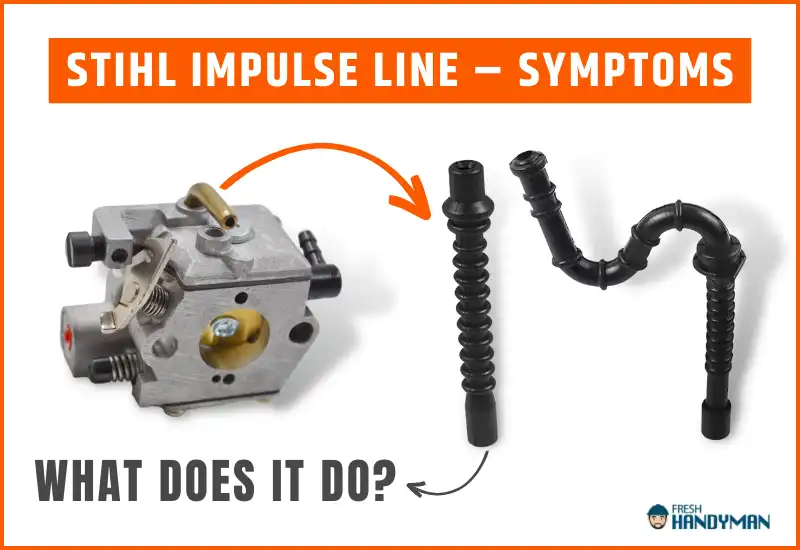
Now what I talked about above gives you a very basic idea about what an impulse line is and what it does. And I know not all of you are here for the short and sweet. So, let me give you a more thorough idea about the impulse line in Stihl chainsaws to help you diagnose and fix any issues that might come up because of it.
What is a Stihl Impulse Line
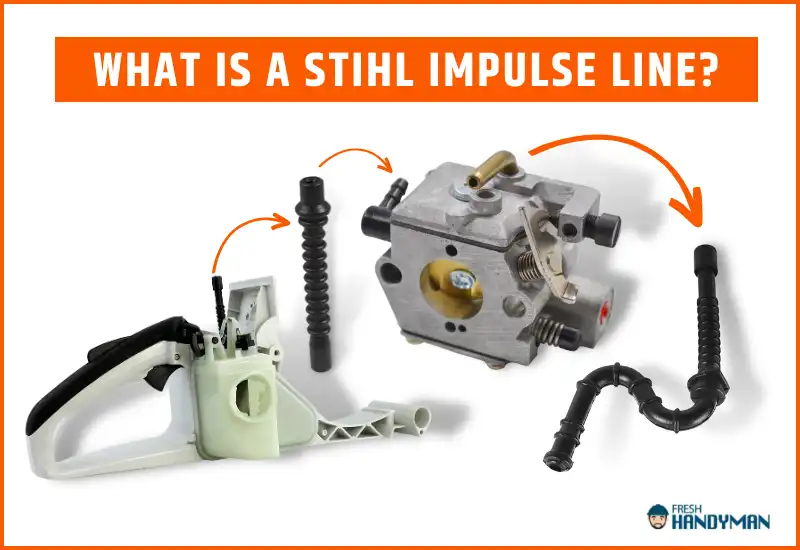
As I already said, the impulse line is what makes the connection between the carburetor and the crankcase in your chainsaw. To truly understand the impulse line in your Stihl chainsaw, however, you need to dig a bit deeper.
Let’s start with the fuel tank. Inside the fuel tank, there’s a fuel filter and a line comes out of the filter and connects to the carburetor. Now the main job of the carburetor is to transfer fuel to the engine by creating positive or negative pressure in its fuel chamber.
On close inspection, you will notice that a second line runs out from the top of the fuel chamber and connects to the crankcase. This is the part known as the impulse line.
So, the main takeaway here is that the impulse line is a pipe that allows constant flow connection from the crankcase to the carburetor. But knowing what an impulse line is and knowing how it works are two different things. And that’s exactly what I want to talk about next.
Primary Functions of the Impulse Line in Stihl Chainsaw
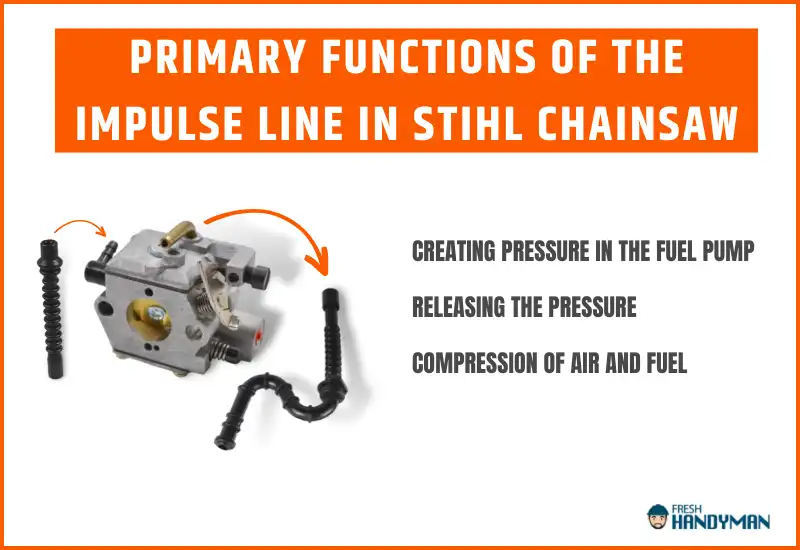
I’ll be honest – understanding the entire function of an impulse line can feel pretty complicated. There’s a lot of scientific mumbo jumbo involved here regarding fluid dynamics and Bernoulli’s Principle. But don’t worry – I won’t burden you with anything that you can’t handle.
However, it is important to understand the primary function of the component if you want to detect issues in the impulse line. So, let me break it down for you into three easy, digestible bits. The entire function of the impulse line can be broken down into three phases or cycles –
Step 1: Creating Pressure in the Fuel Pump
The first step to starting your chainsaw is to pull the rope to turn on the engine, right? What you might not know is that when you are pulling on the rope. The crankshaft is turning inside the engine, which, in turn, lowers the piston.
And as the piston lowers, it applies pressure on the lower crankcase pushing the reed valve down and shutting it off. Because of the impulse line, the remaining pressure transfers through the line and moves toward the pump.
As the pressure moves to the pump, it starts to push the diaphragm in the pump downward. This forces the fuel valve to turn off. This is the first phase of the impulse line.
Step 2: Releasing the Pressure
For the first phase, I talked about what happens when the piston lowers. Now it’s time to look at what happens when the piston starts going upwards. It creates a vacuum creating negative pressure in the pump. In other words, it will start sucking in air from the fuel pump.
At this point, the diaphragm in the fuel pump that was lowered previously will start moving back to its initial position. As a result, it causes a vacuum in the lower part of the pump.
Because of this, the fuel valve opens up again, and because of the negative pressure of the vacuum, the fuel starts filling up the area. This is how the impulse line manipulates the flow of fuel inside the chainsaw. And the first and second steps that I talked about so far make up the first cycle of the impulse line.
Step 3: Compression of Air and Fuel
Once the first cycle is complete, the second cycle begins immediately. The only thing that’s different this time around is that there’s both air and fuel inside the crankcase now. So, let’s see what happens now.
As the piston starts lowering once again, both the air and fuel present inside start getting pressurized. The reed valve shuts off again, and the pressure will travel up the impulse line and move toward the fuel chamber.
Similar to the first cycle, the diaphragm lowers again, and the fuel pump valve shuts off. The excessive fuel leftover moves towards the metering area. Now when the piston goes upwards, and the diaphragm resets its position, there’s another vacuum in the chamber.
Because of this, the next batch of fuel can enter the pump area. This is an ongoing cycle that ensures your engine gets enough fuel all the time for its peak performance.
Symptoms of a Bad Impulse Line
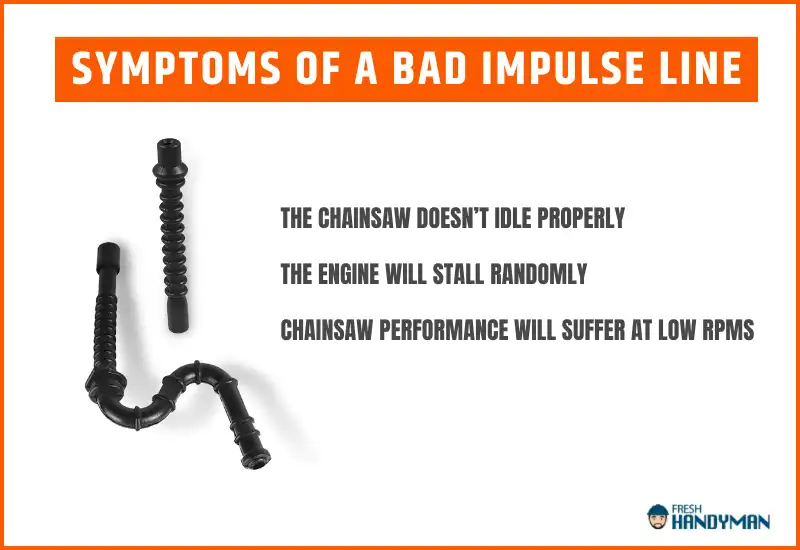
Stihl is one of the best chainsaw brands out there. But that doesn’t mean it won’t have occasional issues every now and then. If you expect the impulse line in your chainsaw to last indefinitely, that’s just not going to happen.
When your chainsaw has a bad impulse line, you will see some weird issues. The most common problem that you might notice is that your chainsaw doesn’t idle properly. It might idle high, and the engine will stall randomly. And while high RPM performance seems fine, your chainsaw performance will suffer at low RPMs.
If you notice any of these issues, then that means your impulse line is bad and needs replacement right away.
Replacing Impulse Line in Stihl Chainsaw
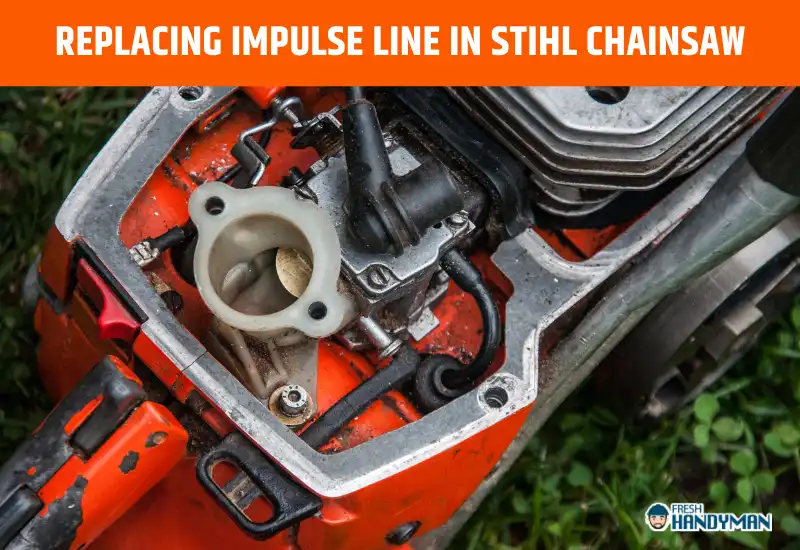
If the impulse line in your Stihl chainsaw is cracked, worn, or damaged in any way, it’s best to replace it as soon as possible. You will probably start noticing the signs way before your impulse line is actually damaged beyond repair. And the best course of action is to repair it the moment you notice any inconsistencies.
However, if the impulse line gets damaged to the extent that your chainsaw just won’t perform as well as it did before, replacing it is the only option. In that case, you want to make sure you are going for either high-end aftermarket parts or factory replacement parts straight from the manufacturer.
I’ll be honest replacing the impulse line involves taking apart your chainsaw and removing components inside as needed. So, if you haven’t done this before and this is your first time, I would recommend taking it to an expert.
You see, replacing the impulse line is simply a matter of swapping out the old line and putting the new one in. But since the impulse line is different in each chainsaw, locating it might be a bit difficult for a new user. You also need to disconnect the fuel line when you are replacing the impulse line.
So, my advice is to take it to a professional for the first time around and observe what he does carefully. That way, you will be able to replace it later if needed.
Stihl Impulse Line Replacement Options
If you decide to go with a replacement part from the manufacturer, there’s not much I need to tell you. Simply reach out to them with the model of your chainsaw, and they should be able to send over a part that fits perfectly. However, if you are going with an aftermarket component, make sure you check its compatibility.
You see, there’s no guarantee that all impulse lines will fit every chainsaw out there. Checking the manual should give you a general idea of the specifications that you need to go with. With that said, let me give you two options that I have used before when I needed to replace the impulse line in my Stihl chainsaw.
- CTS Impulse LINE for STIHL Chainsaw
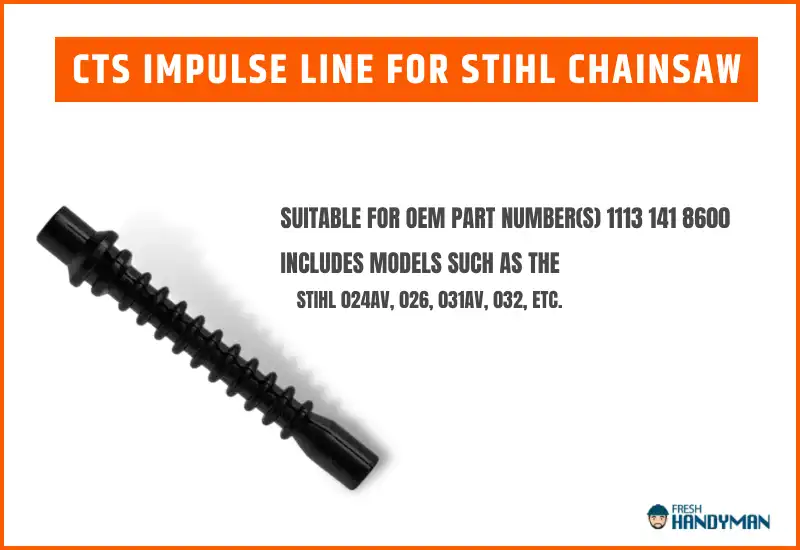
CTS is a very popular brand that mostly deals with aftermarket components for all sorts of tools and equipment. Yes, they make some quality power tools of their own, but it’s their aftermarket parts that I find the most worth mentioning. And the impulse line replacement that they offer for Stihl chainsaws is nothing short of perfection.
This impulse line replacement part is made of high-quality materials and should last you quite a while regardless of how you use it. The one that I used in my old Stihl MS211 that had some problems five years back is still running strong without any signs of slowing down.
But keep in mind – this is not compatible with all Stihl chainsaws out there. It’s only suitable for OEM Part Number(s) 1113 141 8600, which includes models such as the Stihl 024AV, 026, 031AV, 032, etc. Make sure you check out the complete compatibility list to see if your chainsaw fits the bill.
- HURI Fuel Line Oil Line Impulse Line
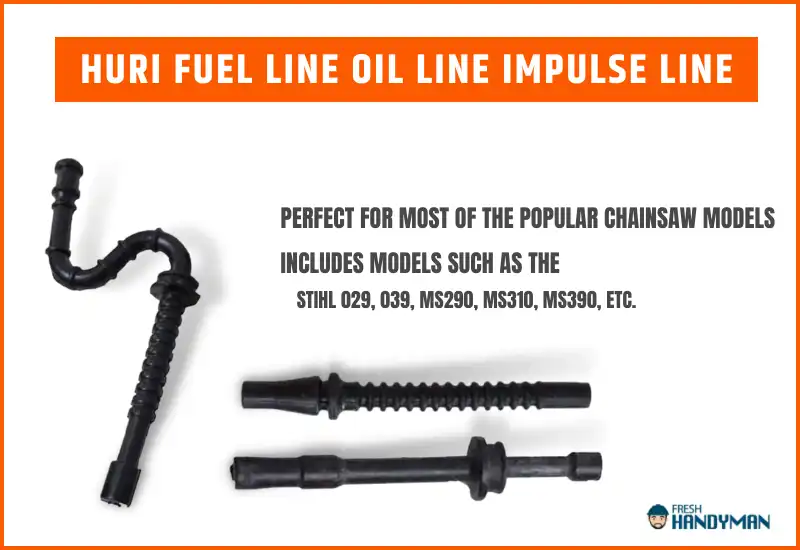
I am the sort of guy that likes to deal with problems before they become too much to handle. And when I see a certain component starting to malfunction, I tend to go all out and give my chainsaw a new makeover. And if you are like me, you wouldn’t stop at replacing your impulse line.
Well, in that case, the HURI line replacement kit might be more up your alley. In addition to a spare impulse line for you to replace, it also comes with a full set of fuel and oil lines that you can swap out to give your chainsaw a new lease on life.
Naturally, it costs a bit more, but what I love about it is how it’s a one-stop solution for all the pipes in your system. Even if you don’t replace the other components, you can save it for a rainy day when you inevitably run into issues because of the fuel or oil line.
As for its compatibility, it works with a pretty nice list of chainsaws. It is perfect for most of the popular chainsaw models, such as the Stihl 029, 039, MS290, MS310, MS390, etc. So, if your chainsaw matches the compatibility list, you should be able to swap one in, replacing your old one without any issues.
Now That We’re Here
A chainsaw can seem complicated, but seasoned users can quickly learn the ropes if they try. When I first started out, things felt tough, but now as soon as a problem crops up, I can tell which component is responsible for it without even having to open it up.
The issues coming up in the impulse line can be a bit difficult to diagnose since a lot of fuel line or engine problems also show the same symptoms. But now that you have a clearer picture of what it does and how it works, you should be able to fix it up or replace it if you ever need it.
I hope my in-depth look into the Stihl impulse line could help you understand it better. Cheers!
